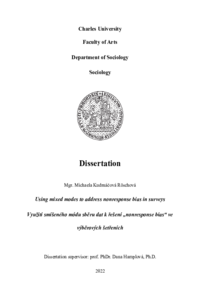Using mixed modes to address nonresponse bias in surveys
Využití smíšeného módu sběru dat k řešení "nonresponse bias" ve výběrových šetřeních
dizertační práce (OBHÁJENO)

Zobrazit/
Trvalý odkaz
http://hdl.handle.net/20.500.11956/179229Identifikátory
SIS: 155305
Kolekce
- Kvalifikační práce [24991]
Autor
Vedoucí práce
Oponent práce
Remr, Jiří
Hruška, Lubor
Fakulta / součást
Filozofická fakulta
Obor
Sociologie
Katedra / ústav / klinika
Katedra sociologie
Datum obhajoby
19. 1. 2023
Nakladatel
Univerzita Karlova, Filozofická fakultaJazyk
Angličtina
Známka
Prospěl/a
Klíčová slova (česky)
nonresponse bias|návratnost|výběrová šetření|smíšený mód sběru datKlíčová slova (anglicky)
nonresponse bias|response rate|surveys|mixed mode of data collectionKlesající návratnost ve výběrových šetřeních, zaznamenávaná v posledních desetiletích, vedla k přesunutí důrazu z návratnosti k nonresponse bias (tj. systematické chybě výběru v důsledku výpadku návratnosti). Snížení nonresponse bias vyžaduje z teoretického hlediska změnit nestejné výchozí pravděpodobnosti účasti vybraných jednotek. Při získávaní vybraných jednotek ke spolupráci je tak třeba rozrůznit postupy nebo vynakládat různou intenzitu úsilí. Zároveň je známé, že implementace strategií k omezení nonresponse bias je náročnější než v případě strategií k navýšení návratnosti, neboť tyto dva aspekty mohou představovat konfliktní cíle, zvláště v kontextu rostoucích nákladů na terénní práce. Tato disertace má za cíl přispět k diskusi ohledně strategií k řešení problému nonresponse bias za podmínek klesající návratnosti a v obecně méně příznivých podmínkách pro realizaci výběrových šetření. Mapuje proto bariéry rozsáhlejšího využití strategií k omezení nonresponse bias a formuluje kritéria, která by měla splňovat strategie využitelnější a přístupnější pro širší spektrum realizátorů výběrových šetření. Tato práce argumentuje, že smíšený mód sběru dat je vhodným kandidátem pro takové řešení. Empirická část práce vyhodnocuje, zda využití CAWI konverze v pravděpodobnostním šetření formou osobního...
Declining response affecting population surveys in the past decades led to a shift of focus from response rate to nonresponse bias. From a theoretical perspective on nonresponse, reducing nonresponse bias requires altering the differential response propensities of sampled units through the application of unequal intensity or type of effort across the units. At the same time, it is acknowledged that implementing nonresponse bias reduction strategies is more challenging than focusing solely on response maximisation because these two may constitute conflicting objectives, especially in the context of increasing fieldwork costs. This dissertation aims to contribute to the discussion on strategies to address nonresponse bias in the conditions of decreasing response rates and under less favourable survey conditions in general. It explores the barriers to a more widespread application of nonresponse bias strategies and formulates criteria for a more feasible nonresponse bias strategy that would be accessible to a wider range of survey entities. It argues that mixed methods are particularly suitable for offering a solution. The empirical part assesses whether the application of a CAWI conversion attempt in a random probability face-to-face survey may serve as a feasible nonresponse bias reduction strategy....
